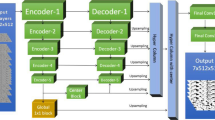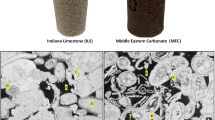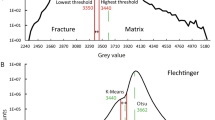Abstract
Image segmentation is an important part of the standard digital rock physics (DRP) workflows. In this paper, we present ground-truthing of digital rock images using texture analysis. We propose a deep learning–based approach for automated segmentation which is validated using the extracted ground-truth. To generate the ground-truth, we utilize the a priori knowledge of minerals and pores. We perform texture based iterative intensity thresholding to calculate the porosity and mineral composition. The ground-truth is generated for the berea sandstone image dataset and the grosmont carbonate image dataset. Results obtained from the experiments conform to the porosity and composition ranges provided in the literature. For the purpose of automated segmentation, we use a SegNet deep network which performs pixel-wise segmentation of digital rock images into pores and minerals. We train and test the SegNet using 1024 images of berea sandstone dataset ground-truthed using iterative intensity thresholding. We utilize a split of 90% and 10% for training and testing, respectively. Experimental outcomes show that the SegNet-based segmentation results for the minerals such as clay, ankerite, and zircon are better than the existing methods.










Similar content being viewed by others
Data availability
The image data used in the experiments is available at: https://github.com/fkrzikalla/drp-benchmarks
References
Abdollahi A, Pradhan B, Gite S, Alamri A (2020) Building footprint extraction from high resolution aerial images using generative adversarial network (gan) architecture. IEEE Access 8:209517–209527
Andra H, Combaret N, Dvorkin J, Glatt E, Han J, Kabel M, Keehm Y, Krzikalla F, Lee M, Madonna C et al (2013) Digital rock physics benchmarks—part i: imaging and segmentation. Comput Geosci 50:25–32
Badrinarayanan V, Kendall A, Cipolla R (2017) Segnet: a deep convolutional encoder-decoder architecture for image segmentation. IEEE T Pattern Anal 39:2481–2495
Chatterjee S (2013) Vision-based rock-type classification of limestone using multi-class support vector machine. Apin 39:14–27
Chen X, Zhou Y (2017) Applications of digital core analysis and hydraulic flow units in petrophysical characterization. Adv Geo-Energy Res 1:18–30
Dvorkin J, Tono H, Carl S, Malone D (2016) Method and system for integrating logging tool data and digital rock physics to estimate rock formation properties. US Patent 9,507,047
Gite S, Agrawal H (2016) On context awareness for multisensor data fusion in iot. In: ICCCT. Springer, pp 85–93
Gite S, Agrawal H (2019) Early prediction of driver’s action using deep neural networks. IJIRR 9:11–27
Han Y, Hu D, Matzar L (2014) Numerical computation of elastic properties for porous rocks based on ct scanned images using direct mapping method. JJ Pet Sci Eng 122:346–353
Huang C, Zhang X, Liu S, Li N, Kang J, Xiong G (2021) Construction of pore structure and lithology of digital rock physics based on laboratory experiments. J Pet Explor Prod Technol 11:2113–2125
Islam A, Chevalier S, Sassi M (2018) Structural characterization and numerical simulations of flow properties of standard and reservoir carbonate rocks using micro-tomography. Comput Geosci 113:14–22
Jiao L, Zhang F, Liu F, Yang S, Li L, Feng Z, Qu R (2019) A survey of deep learning-based object detection. IEEE access 7:128837–128868
Jones B, Feng Y (2016) Effect of image scaling and segmentation in digital rock characterisation. CPM 3:201–213
Kalam MZ (2012) Digital rock physics for fast and accurate special core analysis in carbonates. New Technol Oil Gas Ind 2012:201–226
Karimpouli S, Tahmasebi P (2016) Conditional reconstruction: an alternative strategy in digital rock physicsan alternative strategy in drp. Geophysics 81:D465–D477
Karimpouli S, Tahmasebi P (2019a) Image-based velocity estimation of rock using convolutional neural networks. Neural Netw 111:89–97
Karimpouli S, Tahmasebi P (2019b) Segmentation of digital rock images using deep convolutional autoencoder networks. Comput Geosci 126:142–150
Khade S, Gite S, Pradhan B (2022) Iris liveness detection using multiple deep convolution networks. Big Data Cogn Comput 6:67
Lin W, Li X, Yang Z, Lin L, Xiong S, Wang Z, Wang X, Xiao Q (2018) A new improved threshold segmentation method for scanning images of reservoir rocks considering pore fractal characteristics. Fractals 26:1840003
Madonna C, Almqvist BS, Saenger EH (2012) Digital rock physics: numerical prediction of pressure-dependent ultrasonic velocities using micro-ct imaging. Geophys J Int 189:1475–1482
Mekruksavanich S, Jitpattanakul A (2021) Biometric user identification based on human activity recognition using wearable sensors: an experiment using deep learning models. Electronics 10:308
Nafea O, Abdul W, Muhammad G, Alsulaiman M (2021) Sensor-based human activity recognition with spatio- temporal deep learning. Sensors 21:2141
Pyrcz M, Deutsch C (2014) Geostatistical reservoir modeling. Oxford University Press
Quan Y, Shao Y, Teng H, Xu Y, Ji H (2021) Image denoising using complex-valued deep cnn. Pattern Recogn 111:107639
Ramanujam E, Perumal T, Padmavathi S (2021) Human activity recognition with smartphone and wearable sensors using deep learning techniques: a review. IEEE Sens J 21:13029–13040
Samet R, Amrahov SE, Ziroglu AH (2012) Fuzzy rule-based image segmentation technique for rock thin section images. In IPTA (pp. 402–406). https://doi.org/10.1109/IPTA.2012.6469555.
Saxena N, Hofmann R, Alpak FO, Dietderich J, Hunter S, Day-Stirrat RJ (2017) Effect of image segmentation & voxel size on micro-ct computed effective transport & elastic properties. Mar Pet Geol 86:972–990
Shang R, He J, Wang J, Xu K, Jiao L, Stolkin R (2020) Dense connection and depthwise separable convolution based cnn for polarimetric sar image classification. KnowL-Based Syst 194:105542
Tavanaei A, Salehi S (2015) Pore, throat, and grain detection for rock sem images using digitalwatershed image segmentation algorithm. J Porous Media 18(5):507–518
Wang J, Yang Y, Mao J, Huang Z, Huang C, Xu W (2016) Cnn-rnn: a unified framework for multi-label image classification. In: CVPR, pp 2285–2294
Wang G, Zuluaga MA, Li W, Pratt R, Patel PA, Aertsen M, Doel T, David AL, Deprest J, Ourselin S et al (2018) Deepigeos: a deep interactive geodesic framework for medical image segmentation. IEEE T Pattern Anal 41:1559–1572
Wu X, Sahoo D, Hoi SC (2020) Recent advances in deep learning for object detection. Neurocomputing 396:39–64
Zhao Z-Q, Zheng P, Xu S-T, Wu X (2019) Object detection with deep learning: a review. IEEE T Neur Net Lear 30:3212–3232
Author information
Authors and Affiliations
Corresponding author
Ethics declarations
Conflict of interest
The authors declare that they have no competing interests.
Additional information
Responsible Editor: Biswajeet Pradhan
Rights and permissions
Springer Nature or its licensor (e.g. a society or other partner) holds exclusive rights to this article under a publishing agreement with the author(s) or other rightsholder(s); author self-archiving of the accepted manuscript version of this article is solely governed by the terms of such publishing agreement and applicable law.
About this article
Cite this article
Manzoor, S., Qasim, T., Bhatti, N. et al. Segmentation of digital rock images using texture analysis and deep network. Arab J Geosci 16, 436 (2023). https://doi.org/10.1007/s12517-023-11549-0
Received:
Accepted:
Published:
DOI: https://doi.org/10.1007/s12517-023-11549-0




